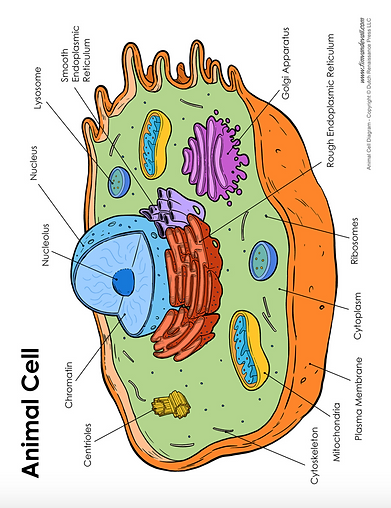STEM ED
In order to understand the unique characteristics of stem cells, one must first understand the basics of what a cell is. All living things are composed of cells, as they are the fundamental unit of life. There are two types of cells: prokaryotic and eukaryotic cells. Prokaryotic cells are thought to be the first type of cells to exist on Earth. They lack the complexity of eukaryotic cells and are usually a whole organism. For example, every bacterium is a prokaryotic cell. Eukaryotic cells, in contrast, contain membrane-bound organelles and are the kind of cell that make up all multicellular organisms. For example, humans are composed of billions of different types of eukaryotic cells. Particular types of eukaryotic cells come together to form human tissues. For example, lots of cardiovascular cells come together to make heart tissue. Then, similar tissues come together to make a whole organ. For example, all the heart tissue comes together to form the heart.
Even though there are many different types of eukaryotic cells, they all share the same parts. Just like humans are composed of a bunch of different organs that do different things, eukaryotic cells are composed of a bunch of different organelles that have specific roles. The following is a list of information about the main organelles of a cell:
-
Nucleus: The nucleus contains the cell’s DNA, which is the genetic material of the cell that rests in the unbound form of chromatin. It is contained by the nuclear envelope, a double membrane that allows mRNA, transcription factors, and other small molecules to pass in and out of the nucleus through nuclear pores. The nucleus is usually located in the center of the cell.
-
Ribosomes: Ribosomes function to produce proteins that are going to be either used by the cell or sent outside of the cell. Protein synthesis occurs when a ribosome attaches to a strand of mRNA. Ribosomes can be found either attached to the rough endoplasmic reticulum or floating around in the cytoplasm of the cell. If the ribosome is attached to the rough endoplasmic reticulum, then the proteins it produces will eventually be sent outside the cell. If the ribosome is not attached to the rough endoplasmic reticulum, then the proteins it produces will be used by the cell.
-
Rough Endoplasmic Reticulum: The purpose of the rough endoplasmic reticulum is to collect and modify proteins that will eventually be sent outside the cell. The rough endoplasmic reticulum sends some of the proteins it collects to the golgi apparatus in lipid membrane-bound vesicles. It is located right next to the nucleus of the cell.
-
Smooth Endoplasmic Reticulum: The purpose of the smooth endoplasmic reticulum is to help produce and store lipids. Some of the lipids that accumulate in the smooth endoplasmic reticulum are used to create the phospholipid membranes of the cell.
-
Golgi Apparatus: The golgi apparatus receives proteins in lipid membrane-bound vesicles from the rough endoplasmic reticulum. Its job is to repackage such proteins and then distribute them in membrane bound-vesicles to locations outside of the cell. The golgi apparatus also produces lysosomes. It is located near the rough endoplasmic reticulum within the cell.
-
Mitochondria: Mitochondria function to produce ATP (Adenosine Triphosphate), the primary molecule that provides energy to the cell so that it can properly do its job. They are usually located throughout the cell, surrounded by cytoplasm.
-
Lysosome: Lysosomes function to break down big molecules and old materials that are no longer needed by the cell. They also digest foreign microbes that threaten the cell. Thus, they consist of digestive enzymes enclosed by a phospholipid bilayer. They are made by the golgi apparatus and are distributed to various areas inside the cell.
-
Plasma Membrane: The plasma membrane is the outer layer of the cell and allows the cell to maintain a distinct internal environment. It is made of a phospholipid bilayer with embedded proteins that control what molecules and materials are allowed into and out of the cell.
-
Cytoplasm: The cytoplasm of the cell is a fluid that fills the space between the plasma membrane and the nuclear membrane. All the organelles of the cell are suspended in it, and it aids in maintaining cell shape.
-
Cytoskeleton: The cytoskeleton is a fibrous network of proteins that runs throughout the cytoplasm of the cell. It helps organelles (such as lysosomes) with motility so that they can move around inside the cell. It allows the whole cell to maintain its shape, helps the cell move as a unit, and provides some protection for the cell.
-
Centrioles: Each cell contains two centrioles that are each made of 9 groups of 3 hollow, tube-like proteins. When it is time for the cell to divide, the centrioles line up the condensed and replicated chromatin (in the form of chromosomes) in the center of the dividing cell. This is so that each resulting cell gets a full set of chromosomes.
Here is what an animal cell and all of its organelles look like:
Basic Cell Biology
LEARN
PRACTICE
Check out these flashcards to help you practice what you've learned about the parts of a cell!
Click Below:
Think you know your stuff? Take this quiz and see how you do!
-
https://www.timvandevall.com/printables/science/animal-cell-diagram-labeled/
-
https://www.centreofthecell.org/learn-play/games/explore-a-cell/
-
https://biomanbio.com/HTML5GamesandLabs/Cellgames/cellexplorerpagehtml5.html
-
https://unlockinglifescode.org/3d-animations-of-the-human-cell
-
http://sciencenetlinks.com/lessons/cells-2-the-cell-as-a-system/
-
https://www.ck12.org/book/CK-12-Biology-Advanced-Concepts/section/3.0/
-
https://www.ck12.org/tebook/CK-12-Biology-Teachers-Edition/section/3.0/
-
https://www.ck12.org/book/CK-12-Biology-Concepts/section/2.0/
MEDIA SOURCES
